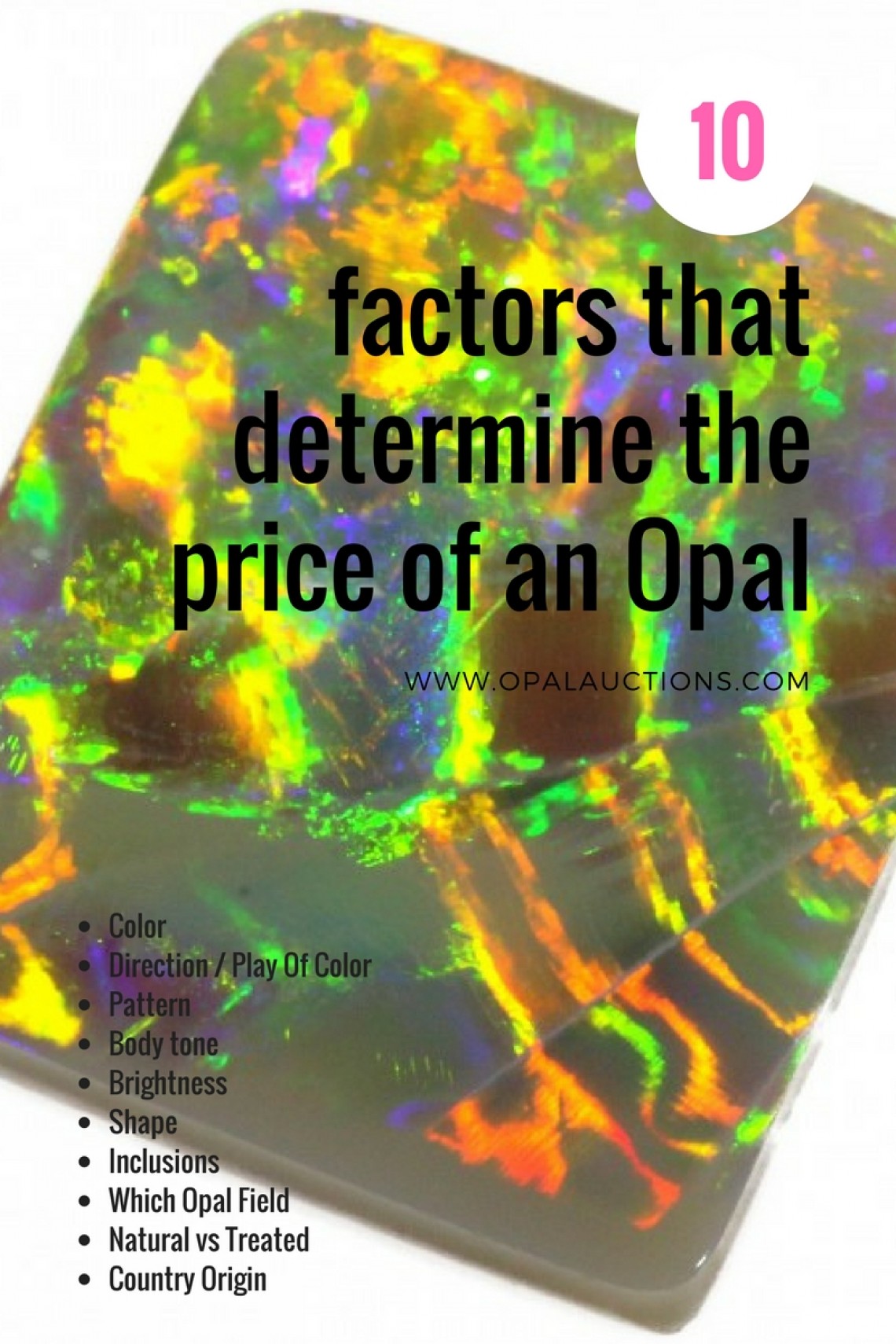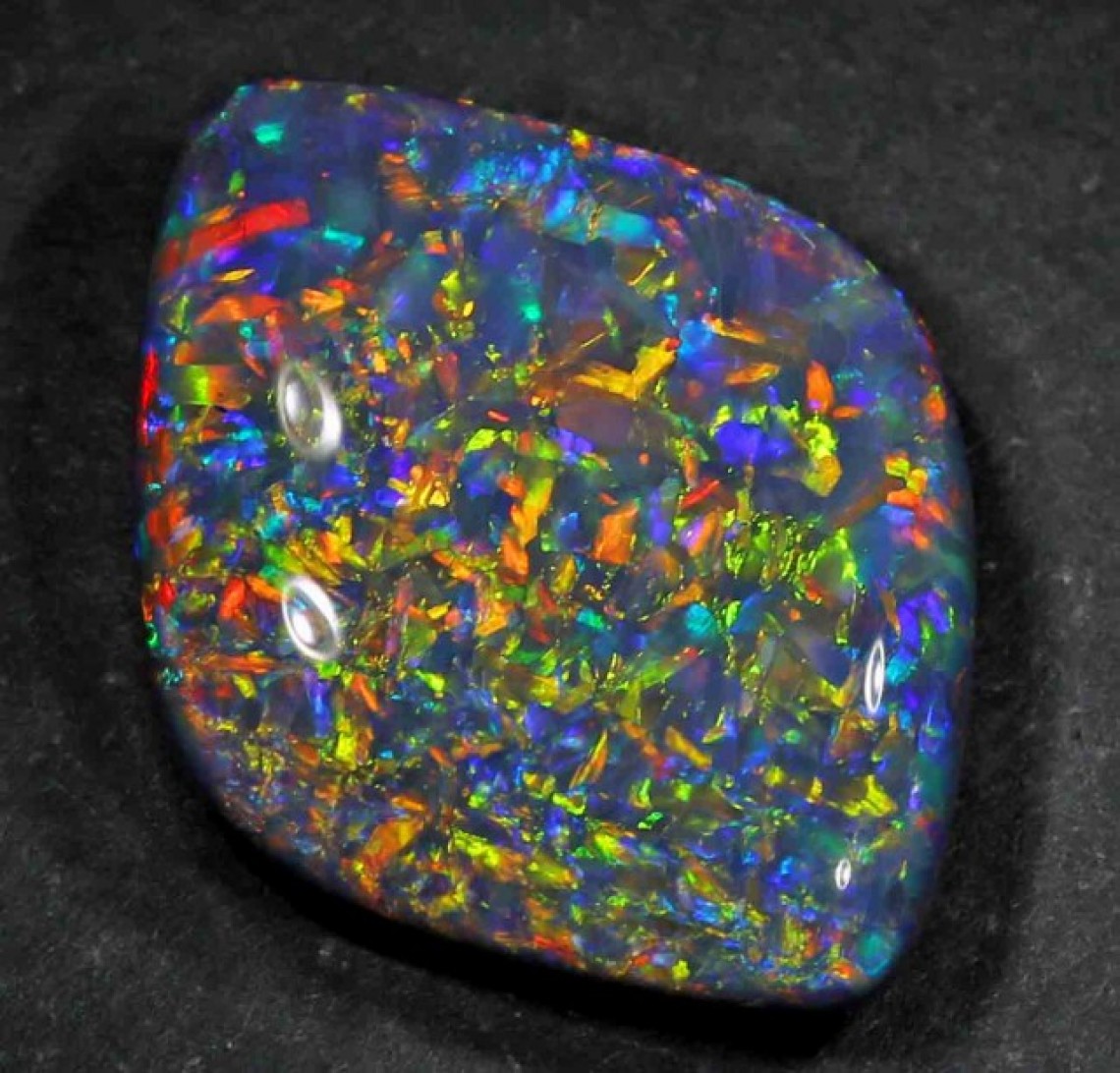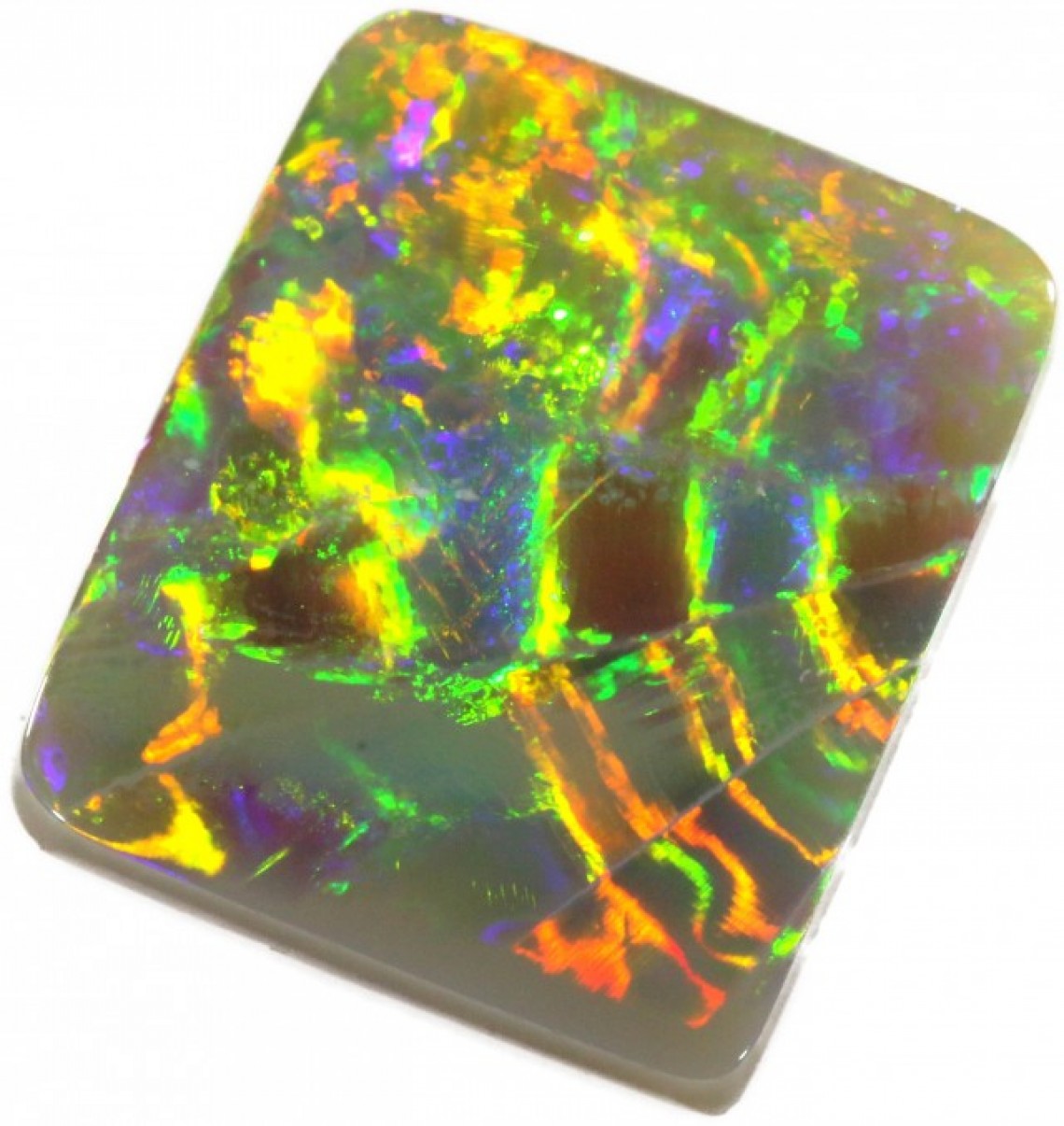
发布时间15th Oct 2020
修改于25th Feb 2024
如何评估蛋白石 - 10 个因素
 从一到十的等级来看,蛋白石无疑是最难评估的宝石。蛋白石有无数的变量,包括颜色、图案、亮度和产地。蛋白石的评估分类系统很复杂,比钻石或任何其他宝石都要难得多。
从一到十的等级来看,蛋白石无疑是最难评估的宝石。蛋白石有无数的变量,包括颜色、图案、亮度和产地。蛋白石的评估分类系统很复杂,比钻石或任何其他宝石都要难得多。
如果您已准备好购买您的第一块蛋白石,或者您是一位狂热的收藏家,那么本文将带您了解影响蛋白石最终价格的 10 个因素。
鉴于有 10 个独立因素会影响蛋白石的最终价格,因此定价会有一定程度的波动。许多蛋白石矿工在考虑供需和销售市场时,可能会低估或高估他们的蛋白石。许多蛋白石拍卖会的买家使用我们的ITEM WATCH来跟踪蛋白石的售价。
多年来,人们已经制定了关于如何评估蛋白石的指导方针。我们将探讨影响蛋白石最终价值的 10 个因素。这些因素包括:
- 颜色
- 方向 / 色彩游戏
- 图案
- 身体色调
- 亮度
- 形状
- 包含内容
- 哪个蛋白石矿场
- 天然与经过处理的
- 原产国
澳大利亚闪电岭的蛋白石价值如何
在澳大利亚的闪电岭,他们有一个委员会,每周六对蛋白石矿工的蛋白石进行估价。几位经验丰富的蛋白石估价师将对蛋白石按克拉进行定价,最终价值将由每克拉的平均价格决定。上述因素可能因人而异,这就是您可能会看到矿工每克拉价格存在差异的原因。
如果您对本文中的任何术语不确定,请查阅我们的词汇表,以获得有关 Opal 世界中几乎所有术语的解释。
颜色
颜色是蛋白石最先引起注意的方面。红色是最稀有、最受追捧的颜色。按价值排序,最有价值的颜色是红色,然后是橙色、绿色、蓝色和紫色。然而,蛋白石通常不会只有一种颜色。重要的是要确定主色是什么,然后是次色。使用主色作为会影响价格的颜色。
一些值得注意的蛋白石是红色蛋白石,里面隐藏着紫色色调的色条。这将产生深沉而庄严的红色。此外,电蓝色蛋白石更有价值,因为隐藏的色条使蛋白石比普通蓝色更亮。
颜色的密度和强度也是决定价格的重要因素。色带的厚度有助于增强蛋白石颜色的亮度。缝线蛋白石的色带通常比结节蛋白石的色带更薄。

颜色方向
蛋白石是一种宝石,其外观会根据观察角度发生巨大变化。当蛋白石最亮时,这被称为“朝向”。颜色的方向会影响价格,因为它将决定蛋白石的多功能性。如果它只朝向一个方向,它可能只适合做吊坠。
- 受到来自各个方向强烈火光照射的蛋白石是制作戒指宝石的上佳之选。这些蛋白石用途广泛,比单一方向的蛋白石更有价值。无论从哪个方向看,优质蛋白石都会看起来很漂亮。
- 面朝一个方向的蛋白石最适合做成吊坠。珠宝商会将其镶嵌在正确的方向,以尽可能多地展示其火彩。
- 一些多色蛋白石可能具有 1 或 2 种强烈的颜色,这些颜色具有不同的方向面,这对于珠宝商来说可能很难镶嵌。
- 死角是指从某个角度看不到任何颜色。死角会降低蛋白石的整体价值。
图案
具有罕见或独特图案的蛋白石更有价值。 杂色图案是蛋白石中最稀有和最受欢迎的图案,但非常罕见。真正的杂色图案是一种马赛克宽图案,有棱角的紧密颜色组合。花卉图案有时被称为花卉杂色。
一些顶级图案包括鲭鱼纹、块状纹、宽闪光纹、滚动闪光纹、针状火焰纹、彩虹纹,而最受追捧的埃塞俄比亚蛋白石则是蜂窝纹。没有图案或只有轻微图案的蛋白石通常价值较低。

身体色调
蛋白石体色指南由澳大利亚蛋白石协会认可,旨在作为黑蛋白石和砾石蛋白石的指南。现在,它已普遍适用于世界各地的所有蛋白石。蛋白石分为 9 个子类别,从 N1 到 N9,其中 N1 是最暗的蛋白石,N9 是最亮的蛋白石。
- 黑蛋白石通常最有价值,色调为 N1 至 N4
- N5 至 N6 的蛋白石被视为半黑或深色蛋白石。
- 体色 N7 至 N9 被称为水晶蛋白石。

亮度
蛋白石亮度指南由澳大利亚蛋白石协会与体色指南一同制作。亮度分为 7 个等级,B1 表示最亮,B7 表示最暗。蛋白石越亮,其价值就越高。 
形状
椭圆形宝石通常被认为比自由形状的宝石更有价值,但砾石蛋白石除外,因为自由形状被认为是理想的选择。蛋白石的形状再次决定了它的多功能性。椭圆形宝石通常具有最佳的色彩,可用于各种用途。
蛋白石几乎总是被切割成凸圆形。凸圆形宝石如果圆顶较高,则比扁平宝石更有价值。这是因为凸圆形宝石是理想的戒指宝石,而扁平宝石则不太受欢迎,因为它们不能用于许多珠宝设计。
包含内容
不要将内含物和裂纹与裂纹混淆。裂纹会反射光线,大大降低蛋白石的价值。值得一读的是有关蛋白石裂纹和开裂之间的区别。
线雕蛋白石没有光反射,这种蛋白石通常价值较低,但可以制作出艺术图案。
一些蛋白石会因内含物而呈现出植被图案,这种图案很受欢迎,因为蛋白石取代了一些树木或植被。沙子或窗户也会降低蛋白石的价值。窗户是底部的缝隙,其中没有形成泥浆,蛋白石是透明的。
埃塞俄比亚蛋白石可能含有幽灵或幻影内含物或植物物质。这些类型的内含物通常被认为是此类蛋白石的合理之选。 
蛋白石场源
最终买家或批发商可能不会考虑这个因素。但在行业中,某些矿场以出产优质原石而闻名,这些原石可以制成优质宝石。澳大利亚和埃塞俄比亚的蛋白石矿场就是这种情况。即使是矿场的深度也会极大地影响价值。
在交易中,这可能是吸引回头客的一个重要因素。如果你发现卖家有你喜欢的某些库存,最好从该群体购买。
天然或经过处理
天然蛋白石的价值总是高于经过处理的蛋白石。过去几年,经过烟熏或处理的埃塞俄比亚水晶蛋白石一直被当作天然黑蛋白石出售。这种处理不是永久性的。蛋白石拍卖行的卖家必须明确说明蛋白石经过了处理。不幸的是,我们现在看到很多假蛋白石出售,不仅在网上,而且还在原石包裹中加香料。
假蛋白石或合成蛋白石也需要警惕。最好学习如何识别假蛋白石。
双层蛋白石和三层蛋白石没有与实心蛋白石相同的严格标准,价值也低得多。与实心蛋白石相比,双层蛋白石的挑选非常重要,而当蛋白石被镶嵌在珠宝中时,这可能很困难。查看以下资源:
原产地
澳大利亚是全球最昂贵的蛋白石产地,这一点在全世界享有盛誉。现在许多国家都出产优质蛋白石,如埃塞俄比亚、墨西哥和巴西。每个国家的蛋白石可能都独一无二,这一因素有助于确定蛋白石的价格。
购买蛋白石
搜索Opal Encyclopedia
相关拍卖
相关文章
最新的文章
蛋白石的价格取决于多种因素,我们已在本蛋白石分级和价格指南中对这些因素进行了详尽说明。了解有关蛋白石分级和每种蛋白石价格的所有信息!
19th Jul 2023
文章分类
All there is to know about Opals including Black Opals, Ethiopian Opals & Boulder Opal
15文章数
Check out our fascinating information and articles on all things amazing in the Opal world
43文章数





![10 RING SIZE DOUBLET FACTORY DIRECT [SOJ24]](https://liveplatforms-production.b-cdn.net/tenants/oa/uploads/images/430000-434999/434746/5383e07b2cac1.JPG?width=480&aspect_ratio=1001%3A1000)


